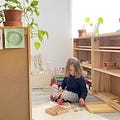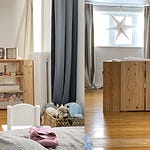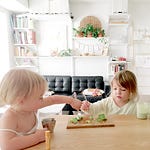This is The Summer Prep Series
The mindset, curation, and organization for a summer of family connection, and growth at home.
…
Framing is everything
How do we turn the principles from Part 2 into storage systems, and organized activities that our children spontaneously clean up after and put back on the shelf when they are done their work?
In our case, and in so many others it doesn’t happen all at once but it is worth every micro-decision, every thrifted rattan tray, and every weekend of disarray as we reorganize our whole house at least yearly to adjust to the changing needs of our family.
This is process that I have gone through over and over again, at home, with friends, and now with clients at Bueno Market. I hope to be able to teach to to do the same, condensing the learning into a simple framework for you to follow.
…
Starting today
In part 1, we worked through respectful parenting and a mindset that released us of the responsibility of fixing our children’s struggling, and instead providing the emotional support for them to work through it themselves.
In part 2, you learned more about my small space, design and education-at-home story and inspiration.
We are now ready to begin 2 processes:
Curation
Organization
Curation
This involves knowing what your family needs - both mind and body, derived from your personal and family values and principles. This is heart, to pen, to paper work you will have to do on your own. Similarly, from behind my keyboard, I can’t tell if your 16 month old is interested in learning about the potty and her how her body can control when it goes or not, or whether your 3 year old has a firm grasp of the number symbols 1-5 and is ready to explore 6 and 7. This 44 page guide from Simone over at The Montessori Notebook provides a simple outline of activities broken out in stages from 6 months old to 3+ years and is a welcomed reminder that children really only need a small shelf with 6 or less activities in our home.
She also provides some home curation wisdom in her notes about the guide:
1. Ages are to give an indication only. Follow your child. See which activities keep their attention; remove those that are too hard or too easy.
2. These activities are not intended for families homeschooling from 3 years +. These activities are intended for the home environment when attending preschool or school.
An example of the shelf space required for 2 of my children’s activities soon after we moved in to our current home.
That is to say, the family home is never static, and specifically, the shelves where you display your children’s activities is expected to be in rotation every couple months as our children grow and change, along with their skill and interests. If they transition to daycare or schooling outside of the home, the activities can be limited further, with some additional activities making an appearance on weekends.
Equally important, is to create space for activities to be taken away and stored, often for 6+ months, when they are not appropriate to the child’s stage or their focus is on mastering something else. In a recent visit to my 5 year olds Montessori classroom for an observation I asked “where do you keep all of the activities not in use?”. The response was given with a sweeping gesture of the assistant’s hand “That is what all of of this storage space is for. It is not for daily access.” This matches my experience at home.
Helpful Notes:
Once a year I find myself looking through this storage to remove any items my children no longer have use for. This ritual is one that is often accompanied by tears as I take some time to reflect on how far my little ones have come in the months past.
I also set aside some time to note what my children are showing interest in a handful of times throughout the year. I’ll do it on separate days for each child so as to keep my thoughts on each of their needs clearly separated.
I make sure to purchase activities ahead of their developmental needs and inline with our values and principles, to avoid impulse purchases, to take advantage of sales or thrifted and second hand gems, and to ensure I have it ready for when the spark comes.
Organization
Taking Marie’s correct order as given, I begin with clothing, a changing of the seasons as my prompt, 4 times a year. 1 or 2 of those times will continue into a partial or whole house reorganization, depending on how well our space is functioning for us. This season is one of those times for us to take a look at everything once again.
Marie would tell you to take everything of one kind and group it so that you can first assess what needs to be discarded, or in my ideal world, loved elsewhere. In the context of a family, this can get messy as the animals that are my children awaken their natural states of entropy at the first sign of changing household order. Don’t worry - they fall back into their natural love of order, thriving and beaming with pride with their ability to maintain the space as soon as the process is complete.
Here’s how it it looks:
Pick a drop space. This is where you will gather all of the like items. It should be out of the way of daily activities - an important tip for routines to continue as normal for families. This week I transitioned the kids creative area into a fresh library and music space. You can follow along as I share the process on Instagram @buenomarket this week.
Group items. Search high and low, gathering all of these items in that drop space. Like me, you might find books in the bathroom, under beds, hidden behind clothing baskets, in the kitchen, and tucked under sofa cushions.
Discard. Appreciate your decision making abilities and curation powers to keep only that which is serving your family. Keep your standards unapologetically high. Decide what needs to go. I create a waste pile for anything too damaged or that I can’t commit to repairing, and the rest goes into my donation storage in the basement, a process we can explore in a future post.
Sort and assign storage space. Whether you are using existing storage or adding to your space, I recommend creating some sort of order to these items and storing them according to that. Pinterest “Konmari method…” to find inspiration for organizing anything from hair accessories to your kitchen pantry. “Montessori shelf/storage” or similar searches will help you find displays specific to your children’s activities.
Introduce the family to the new system. Just as you would with a new learning material, walking your child and any other family members or caretakers through the newly organized space not only prepares them to take care of it, but also models the joy and pride you feel in it. Be slow, careful and descriptive with your words and gestures. After all, your children are looking to you as an example of how to interact with the space.
When things inevitably are found out of place, offer your child another tour. Or ask them to share what they know about caring for the space. You might just find yourself among a child scurrying to clean up so that they can give you a tour of what the space should be kept like followed by clear instructions on where everything goes.
…
In part 3 we’ll explore storage strategies that work for families. High level we’ll look at creating different activity area around your home, and then we’ll narrow in on the details of displaying different types of activities in ways that are accessible, easy to clean up, by both children, and inevitably by adults too, and that invite your children to engage in work and play.
Wishing you a week of gathering, discarding, sorting, and displaying with love and care. I’ll be doing the same :)
Did you enjoy this post? Sharing my work is 100% my love language! My heart would be so happy to see that you took a moment to this over to a few friends, or shared this on your local community or personal social media. Thank you friends and see you in Part 3!
…
What’s next for Raise In Place? Here’s The Summer Prep Series schedule:
Part 1’s resources + weekend challenge
Part 2: Curation + Organization
Part 2’s follow up resources (you are here!)
June 21st - Part 3: Curation + Organization
June 24th - Part 3’s follow up resources + summer challenge
July 26th - Half-way Check-in
August 30th - Summer Reflection
Until next time,
Erika
…
This newsletter is called Raise In Place, and is the newsletter companion to my Residential Design Consulting Services + Shop, Bueno Market. This Summer Prep post is part of a series inside that newsletter called The Summer Prep Series.
www.buenomarket.com
IG @buenomarket.com
TW @thebuenomarket
Questions, comments, requests > erika@buenomarket.com










Methods In Action